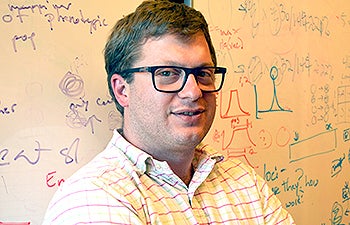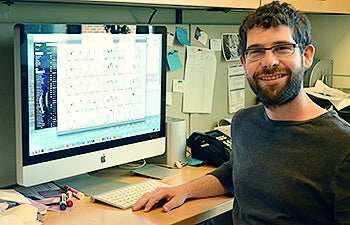Breaking the Genetic Code
Scientists at USC Dornsife have definitively demonstrated that large sets of variations in the genetic code that do not individually appear to have much effect can collectively produce significant changes in an organism’s physical characteristics.
Studying the budding yeast Saccharomyces cerevisiae, USC Dornsife’s Matthew Taylor, a Ph.D. student in molecular and computational biology, and Ian Ehrenreich, assistant professor of molecular biology, found that the effects of these genetic variants can depend on four or more other variants in an individual’s genome.

Ian Ehrenreich, who studies how DNA specifies the characteristics of organisms, stands at his work board.
Most genetic analyses of heritable physical characteristics, including genome-wide association studies in human populations, focus on so-called “additive” variants that have effects that occur regardless of the organism’s genetic background. Taylor and Ehrenreich, however, found that higher-order interactions of five or more places along the genome can have major impacts, and may help explain the so-called “missing heritability” problem, in which additive genetic variants do not entirely explain many inherited diseases and traits.
“Studies focused only on additive effects often explain just a fraction of the genetic basis of many traits. The question is, what are we missing?” said Ehrenreich, corresponding author of a paper on the study that was published by PLOS Genetics on May 1.
An alternative view of Taylor and Ehrenreich’s findings is that genetic variants that have the potential to cause major changes in an organism’s phenotype can be completely canceled out if they occur in the “wrong” genomic background.

Matthew Taylor at his computer: “We hope that this will open the door for future studies to tease apart how these complex interactions happen,” he said.
“It’s exciting to provide a characterized example of how genetic background can influence the effects of mutations. We hope that this will open the door for future studies to tease apart how these complex interactions happen,” Taylor said.
Their work could impact genetic mapping studies, suggesting that researchers will need to take an approach to understanding the genotype-phenotype relationship that encompasses complex non-additive effects.
Taylor and Ehrenreich plan to take a closer look at the molecular mechanisms that underlie these interactions, in the hopes of providing basic insights into how they occur in biological systems.
This research was funded by grant R21AI108939 from the National Institutes of Health and grant MCB1330874 from the National Science Foundation.